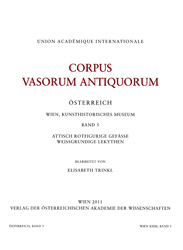 |
Corpus Vasorum Antiquorum
|
 Elisabeth Trinkl ist wissenschaftliche Mitarbeiterin am Institut für Kulturgeschichte der Antike der ÖAW |
In dem fünften Band der Reihe Corpus Vasorum Antiquorum (CVA) Österreich werden 123 Keramikgefäße der Antikensammlung des Kunsthistorischen Museums Wien besprochen; 122 sind vollständig oder weitgehend vollständig erhalten, eines liegt nur als Fragment vor. Obwohl viele Gefäße vor mehr als 200 Jahren ausgegraben wurden, werden sie hier mehrheitlich erstmals vollständig – inklusive eines umfangreichen wissenschaftlichen Apparates – publiziert. Alle Gefäße entstammen der klassischen Zeit (5. und 4. Jahrhundert v. Chr.) und sind in Attika (Griechenland) hergestellt worden. Bei den in rotfiguriger Technik gefertigten Gefäßen handelt es sich überwiegend um Ölbehälter und Weinkannen mit Motiven aus dem Alltagsleben oder mit Tierdarstellungen. Ferner werden hier weißgrundige Lekythen vorgestellt, die in sepulkralem Kontext Verwendung fanden.
Im Rahmen der Bearbeitung der Gefäße kamen naturwissenschaftliche Untersuchungen und aktuelle Dokumentationsmethoden zum Einsatz: 3D-Laserscanner, Spektrometer, Röntgen, RFA (Röntgenfluoreszenzanalyse), UV- und IR-Aufnahmen sowie Untersuchungen unter dem Mikroskop. Die Ergebnisse und Analysen dieser Messungen flossen in den Band ein.
… The fifth volume in the series Corpus Vasorum Antiquorum Austria covers 123 objects of pottery held in the Collection of Greek and Roman Antiquities of the Kunsthistorisches Museum in Vienna; 122 of these items are unbroken or nearly complete, one item is a fragment. Although most of these pieces were excavated more than two hundred years ago, the vast majority are presented here, with comparisons and references, for the first time. All objects date to the Classical period (5th and 4th century BC) and were produced in Attica, Greece. Many of the red-figured pots were used for storing oil and serving wine. They are decorated with animals and depictions of everyday life. |
 |
Verlag der Österreichischen Akademie der Wissenschaften Austrian Academy of Sciences Press
A-1011 Wien, Dr. Ignaz Seipel-Platz 2
Tel. +43-1-515 81/DW 3420, Fax +43-1-515 81/DW 3400 https://verlag.oeaw.ac.at, e-mail: verlag@oeaw.ac.at |
|
||||||||||||||||||||
|
DATUM, UNTERSCHRIFT / DATE, SIGNATURE
BANK AUSTRIA CREDITANSTALT, WIEN (IBAN AT04 1100 0006 2280 0100, BIC BKAUATWW), DEUTSCHE BANK MÜNCHEN (IBAN DE16 7007 0024 0238 8270 00, BIC DEUTDEDBMUC)
|
